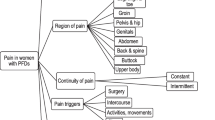Abstract
Introduction and hypothesis
Patient perception of adverse events (AEs) after pelvic floor disorder surgery is incompletely understood and may differ from providers’ views of AEs. Our objective is to describe patient perceptions of AEs related to pelvic floor disorder surgery and how perceptions change over time.
Methods
Mixed-method study of longitudinal patient interviews and surveys. Women planning pelvic floor disorder surgery completed three one-on-one interviews: preoperatively (< 12 weeks before surgery), 6–8 weeks postoperatively, and 6 months postoperatively. Interviews explored the patient experience of surgery and their perception of AEs over time. Participants ranked self-identified AEs by severity. De-identified transcripts of audio recordings were coded and analyzed using an iterative, thematic, team-based process using NVivo software (QSR International).
Results
Twenty women each completed three separate interviews for a total of 60 interviews. Their mean age was 55.3 (± 12.7) years, and 50% were Non-Hispanic white. Women’s perceptions of AEs changed as more time passed from surgery. Women identified potential problems related to surgery such as anesthesia complications, pain, injury, catheter issues, and an unsuccessful surgery as the most concerning AEs preoperatively. Postoperatively (6–8 weeks), women expressed concern about functional outcomes (e.g., performing daily activities, symptom reduction). Late postoperatively (6 months), the majority identified unsuccessful surgery, incontinence, and sexual dysfunction as severe AEs. These findings are consistent with prior work that suggests women perceive functional outcomes as fundamental to their recovery.
Conclusions
These findings contribute to a more nuanced understanding of patient-centered perspectives on AEs. Patients view poor functional outcomes as severe AEs.


Similar content being viewed by others
References
Srikrishna S, Robinson D, Cardozo L, Cartwright R. Experiences and expectations of women with urogenital prolapse: a quantitative and qualitative exploration. BJOG Int J Obstet Gynaecol. 2008;115(11):1362–8.
Mamik MM, Rogers RG, Qualls CR, Komesu YM. Goal attainment after treatment in patients with symptomatic pelvic organ prolapse. Am J Obstet Gynecol. 2013;209(5):488.e1–5.
Lawndy SSS, Withagen MI, Kluivers KB, Vierhout ME. Between hope and fear: patient’s expectations prior to pelvic organ prolapse surgery. Int Urogynecol J. 2011;22(9):1159–63.
Wei JT, Nygaard I, Richter HE, Nager CW, Barber MD, Kenton K, et al. A midurethral sling to reduce incontinence after vaginal prolapse repair. N Engl J Med. 2012;366(25):2358–67.
Visco AG, Brubaker L, Richter HE, Nygaard I, Paraiso MFR, Menefee SA, et al. Anticholinergic therapy vs. onabotulinumtoxina for urgency urinary incontinence. N Engl J Med. 2012;367(19):1803–13.
Barber MD, Brubaker L, Burgio KL, Richter HE, Nygaard I, Weidner AC, et al. Comparison of 2 transvaginal surgical approaches and perioperative behavioral therapy for apical vaginal prolapse: the OPTIMAL randomized trial. JAMA. 2014;311(10):1023–34.
Dindo D, Demartines N, Clavien P-A. Classification of surgical complications: a new proposal with evaluation in a cohort of 6336 patients and results of a survey. Ann Surg. 2004;240(2):205–13.
Clavien PA, Barkun J, de Oliveira ML, Vauthey JN, Dindo D, Schulick RD, et al. The Clavien-Dindo classification of surgical complications: five-year experience. Ann Surg. 2009;250(2):187–96.
Gutman RE, Nygaard IE, Ye W, Rahn DD, Barber MD, Zyczynski HM, et al. The pelvic floor complication scale: a new instrument for reconstructive pelvic surgery. Am J Obstet Gynecol. 2013;208(1):81.e1–9.
Elkadry EA, Kenton KS, FitzGerald MP, Shott S, Brubaker L. Patient-selected goals: a new perspective on surgical outcome. Am J Obstet Gynecol. 2003;189(6):1551–7 discussion 1557-1558.
Dunivan GC, Sussman AL, Jelovsek JE, Sung V, Andy UU, Ballard A, et al. Gaining the patient perspective on pelvic floor disorders’ surgical adverse events. Am J Obstet Gynecol [Internet]. 2018 [cited 2019 Jan 1]. Available from: http://www.sciencedirect.com/science/article/pii/S0002937818309177
Barber MD, Kuchibhatla MN, Pieper CF, Bump RC. Psychometric evaluation of 2 comprehensive condition-specific quality of life instruments for women with pelvic floor disorders. Am J Obstet Gynecol. 2001;185(6):1388–95.
Scheier MF, Carver CS, Bridges MW. Distinguishing optimism from neuroticism (and trait anxiety, self-mastery, and self-esteem): a reevaluation of the life orientation test. J Pers Soc Psychol. 1994;67(6):1063–78.
Wren PA, Janz NK, FitzGerald MP, Barber MD, Burgio KL, Cundiff GW, et al. Optimism in women undergoing abdominal sacrocolpopexy for pelvic organ prolapse. J Am Coll Surg. 2008;207(2):240–5.
Srikrishna S, Robinson D, Cardozo L. Validation of the patient global impression of improvement (PGI-I) for urogenital prolapse. Int Urogynecol J. 2010;21(5):523–8.
Sung VW, Kauffman N, Raker CA, Myers DL, Clark MA. Validation of decision-making outcomes for female pelvic floor disorders. Am J Obstet Gynecol. 2008;198(5):575.e1–6.
Angioli R, Plotti F, Capriglione S, Aloisi A, Aloisi ME, Luvero D, et al. The effects of giving patients verbal or written pre-operative information in gynecologic oncology surgery: a randomized study and the medical–legal point of view. Eur J Obstet Gynecol Reprod Biol. 2014;177:67–71.
Acknowledgements
Ms. Katherine Mulle, for data collection and research coordination.
Financial support
This project was supported in part by the Dedicated Health Research Funds from the University of New Mexico School of Medicine and the University of New Mexico Clinical and Translational Science Center (UL1TR001449).
Author information
Authors and Affiliations
Corresponding author
Ethics declarations
Conflicts of interest
Gena C Dunivan receives research support from Pelvalon Inc. and Viveve. Rebecca G Rogers, MD, receives royalties from UptoDate and travel and stipend from ACOG, ABOG, and IUGA. Yuko M Komesu, MD, receives research support from Cook Myosite®. All other authors report no disclosures..
Additional information
Publisher’s note
Springer Nature remains neutral with regard to jurisdictional claims in published maps and institutional affiliations.
Rights and permissions
About this article
Cite this article
Dunivan, G.C., McGuire, B.L., Rishel Brakey, H.A. et al. A longitudinal qualitative evaluation of patient perspectives of adverse events after pelvic reconstructive surgery. Int Urogynecol J 30, 2023–2028 (2019). https://doi.org/10.1007/s00192-019-03998-7
Received:
Accepted:
Published:
Issue Date:
DOI: https://doi.org/10.1007/s00192-019-03998-7




